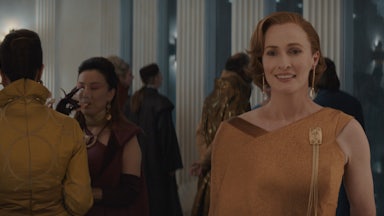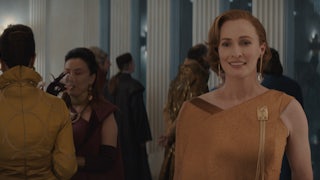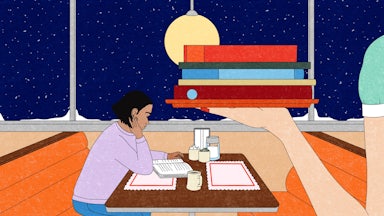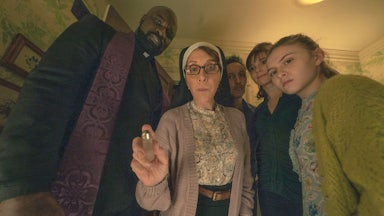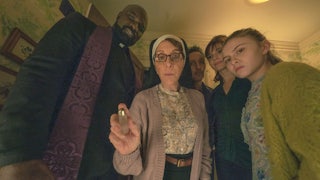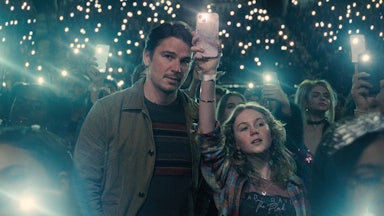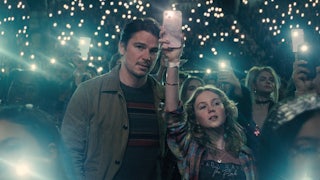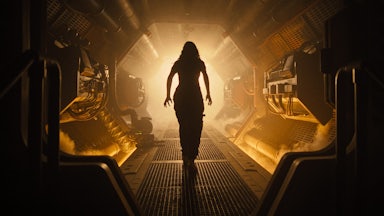On Wednesday, I became the first member of the public to watch something countless cinephiles have waited decades to see: Jerry Lewis’s footage of himself playing a clown in the Holocaust. Donated to the Library of Congress in 2015 and the subject of a persistent stream of inquiries and speculation, the footage has finally become available after a nine-year embargo. I checked in for my appointment to see it at 8:30 a.m. at the Moving Image Research Center, where, for the better part of five hours, I watched the “king of comedy” do bits in the very concentration camp that my grandmother survived.
An unfinished film whose premise is as surreal as it is infamous, The Day the Clown Cried stars Lewis as Helmut Doork, a washed-up and self-involved former Ringling Brothers clown who, through a series of misfortunes, ends up in Auschwitz. As described by Lewis himself, “the clown in the movie is a sort of Pied Piper … who, in the end, is expected to lead the children—and himself—to the ovens.” Many have wondered whether The Day the Clown Cried is the worst film ever shot. Speaking to Spy magazine, Harry Shearer described the rough cut he saw as “so drastically wrong, its pathos and its comedy … so wildly misplaced, that you could not, in your fantasy of what it might be like, improve on what it really is.” The 1972 shoot was highly dysfunctional, leaving Lewis, in his own words, “exhausted, beaten.” The Day the Clown Cried was never completed, and most of the footage has never surfaced publicly due to a litany of legal and financial disputes. Ever since the project was shelved, movie buffs across the world have been trying to get their hands on it, their interest further excited by the comedian’s reluctance to discuss the film later in life: “It was all bad and it was bad because I lost the magic,” Lewis told Reuters in 2013.“You will never see it, no-one will ever see it, because I am embarrassed at the poor work.”
As the grandson of an Auschwitz survivor, as a scholar studying the Holocaust, and as a former fellow at the Library of Congress, I have been desperate to see Lewis’s footage for years—in one sense genuinely curious, and in another, hopelessly drawn to that which might haunt me. What I witnessed over the course of those five hours surprised me. Could it be that The Day the Clown Cried has been unfairly maligned?
In length, the five hours of footage and almost two hours of audio recordings at the Library of Congress far exceed the snippets of The Day the Clown Cried shoot that have surfaced on the internet over the years. Fragmentary, nonsequential, without sound, and filled largely with behind-the-scenes shots and repeated takes of just a few scenes from the end of the film, the footage I saw is perhaps best understood less as a movie than as a portal into the European shoot, which was by many accounts grueling and chaotic. The behind-the-scenes footage captures Jerry Lewis and the cast at various locations, not just filming The Day the Clown Cried but also preparing for the shoot and goofing off: Lewis throwing a baseball surrounded by a transfixed crowd of cast members in concentration camp garments and SS uniforms; Lewis as Doork doing various gags as a clown; Lewis as Lewis in a bathrobe, pretending to chomp his colleague’s head for the camera during a meal. The audio clips contain many takes of music and dialogue for scenes at the beginning of the film, in which Doork is fired from the circus. Listening to the same introductory circus music play over and over again left my head spinning.
I spent a few afternoons this summer reading through the Jerry Lewis Papers held at the Library of Congress, and Lewis’s daily itineraries from the shoot further elucidate the stresses that counterbalance the levity of the behind-the-scenes footage. Lewis slept as little as two hours a night. His itinerary for the first day of shooting, on March 20, 1972, describes a 15-hour workday that ends with an entry at 10:30 p.m.: “EAT & DIE!!” His itinerary for June 10, 1972, the final day of the shoot, evokes the dissonance of the film itself:
3:30 A.M. WAKE-UP
4:00 A.M. HOMEWORK
6:00 A.M. BREAKFAST - DRESS
6:30 A.M. DRIVE TO STUDIO
7:00 A.M. RUSHES!
8:30 A.M. LOCATION - MAKE-UP
9:00 A.M. DRESS
9:30 A.M. SHOOT INT. HUT
1:00 P.M. LUNCH
2:00 P.M. SHOOT EXT. HUT
2:30 P.M. “THE CHAMBER”
5:00 P.M. SHOOT
8:30 P.M. WRAP CREW
9:00 P.M. GOODBYES!!
9:30 P.M. DRIVE TO HOTEL
10:00 P.M. PACK
11:30 P.M. DINNER
1:00 A.M. SNOOZE
Much of the 90 minutes of dailies are from this very day, as well as the couple of days preceding it. The footage is haunting. There are repeated takes of Lewis as Doork, on the verge of tears, leading the children from the hut they are kept in at Auschwitz. In take after take, they walk in a long procession to the gas chamber while Doork tries to mollify them—commanded to do so in order to be spared. Most evocative is the image of Doork changing his mind at the last minute and choosing to die with the children, grabbing a little girl’s hand and leading her into the chamber. A guard closes and locks the door behind them, and the camera pans up to show the chimney, foreshadowing their fate.
By the time that Lewis agreed to direct and star in The Day the Clown Cried, he had been a household comedy name for a quarter-century: as the funny man of the famed duo Martin and Lewis, as the star of box office hits like 1963’s The Nutty Professor, and as the host of the Muscular Dystrophy Labor Day Telethon, which raised millions of dollars annually (Lewis’s brand of physical comedy would inspire successful actors ranging from Steve Martin to Jim Carrey to Nicolas Cage). It was undoubtedly bizarre to watch Lewis don the familiar concentration camp iconography of striped gray pants while wearing a red nose and white face paint, but the scenes I saw reveal a depth to the pairing of Lewis and the Holocaust that belied its reputation as irredeemable. Among the range of emotions I experienced, offense was not one of them—something I cannot say for most of Hollywood’s Holocaust films.
More than 50 years after it was filmed, The Day the Clown Cried is provoking a surge of interest. In addition to Lewis’s footage being made available at the Library of Congress, a documentary about it is premiering at this year’s Venice Film Festival, and producer Kia Jam just acquired rights to the script. Perhaps its reputation is in for a renovation. Having seen Lewis’s footage, I find it hard to believe that the movie would stand out among Holocaust films as uniquely campy or profane, had it been properly finished and released in cinemas. The footage I saw of the film’s ending is not distasteful to me like the conclusion to the family movie The Boy in the Striped Pajamas, in which the concentration camp commandant’s young son and his Jewish friend are mistakenly led into the gas chamber—the camera revealing a man wearing a gas mask pouring Zyklon B overhead. After all, there are plenty of bad Holocaust films out there, whether blindingly sentimental, historically inaccurate, or just poorly made. If anything, the film most closely resembling The Day the Clown Cried is the Academy Award–winning and oft-celebrated La Vita È Bella, or Life is Beautiful, with one simple yet extraordinary difference: In the words of French film critic Jean-Michel Frodon, Lewis “does not dance around the subject matter, the extermination of Jews by the Nazis, including the mass killing of children.”
Perhaps much of the intrigue about The Day the Clown Cried derives merely from the fact that, in Frodon’s estimation, “officially, it does not exist.” Except for the short clips that have leaked over the years, and the footage and audio clips I accessed at the Library of Congress, we have been left to daydream Lewis as a clown in Auschwitz, our imaginations running unchecked. The collective obsession surrounding the film and how awful it supposedly is tells us less about the film itself and more about ourselves: what we enforce as proper Holocaust representation, how we are supposed to respond to it, and our pull toward transgression.
Though taboo among most, a sense of humor about the Holocaust is useful, if not essential, for families of Auschwitz survivors—my own included—as a form of intergenerational healing through memory. Unlike most Holocaust films, the footage that I saw did not shy away from the question of how moral it is to find humor in atrocity, and paid the price in people’s imaginations. The takes of Lewis as Doork doing bits for the children through the barbed-wire fence—a source of joy for the Jewish children, a source of gratification for Doork, and eventually, a tool of exploitation for the SS—are provocations that made me profoundly sad but also made me laugh (the bits are, after all, quite funny). I felt guilty for laughing; I questioned my guilt. Just as the film itself remains unfinished, my feelings remain unresolved. The intimate, complex relationship between tragedy and humor was fundamental to Lewis’s approach to performing. “I only need to call upon my sorrow to create laughter,” he told Parade magazine in 1984. The footage I saw, far from offering some outrageous insult to my sensibilities, invites us to explore this precarious balance, and the conventional limits and purposes of humor as well—not just when it comes to atrocity, but also in the viewer’s life.
It is only fitting that The Day the Clown Cried does not exist in final form. Like memory itself, the footage that I saw and the audio clips I listened to amount to a collection of discontinuous and jumbled fragments that leave you to piece together what is there and imagine what is not. When you do so, the reconstituted shards form a sort of mirror, reflecting back how we remember.

